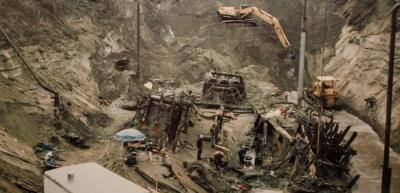Amazing story: the Wreck of the Steamship Arabia
 Sometimes, as we Roadtrek across North America in our RV, we run into stories that are so amazing that you don’t know how to categorize them. So it was with us in downtown Kansas City when we toured one of the most fascinating museums we have ever seen.
Sometimes, as we Roadtrek across North America in our RV, we run into stories that are so amazing that you don’t know how to categorize them. So it was with us in downtown Kansas City when we toured one of the most fascinating museums we have ever seen.
It’s a museum devoted to the Steamboat Arabia, which sunk after running into a tree snag in the muddy Missouri River on September 5, 1856 as it was carrying 200 tons of supplies destined for a string of frontier towns to the west.
 But like the fabled King Tut’s Tomb, the recovery of the Arabia and the cargo it was carrying almost defies belief. The Arabia’s wreckage contained the largest single collection of pre-Civil War U.S. artifacts ever discovered – remarkably preserved clothing, tools, guns, dishware, window glass, candles, jewelry, wine and other everyday items that serve as a time capsule of life on the American frontier. There are even bottles of still pleasantry fragrant 19th century perfumes.
But like the fabled King Tut’s Tomb, the recovery of the Arabia and the cargo it was carrying almost defies belief. The Arabia’s wreckage contained the largest single collection of pre-Civil War U.S. artifacts ever discovered – remarkably preserved clothing, tools, guns, dishware, window glass, candles, jewelry, wine and other everyday items that serve as a time capsule of life on the American frontier. There are even bottles of still pleasantry fragrant 19th century perfumes.
But I don’t know if it’s the amazing items found in the wreckage or the actual discovery and retrieval of those artifacts that is the most interesting.
Because the Arabia was discovered not at the bottom of the Missouri, where she sank, but 45 feet down in the idle of a Kansas cornfield a half mile from the current banks of the river.
Over 400 steamboats have sunk in the Missouri over its 2,500 mile course. Most are undiscovered.
The Arabia was a side-wheel steamer, carrying passengers and cargo on a regular route and schedule. At 171 feet long and capable of carrying 222 tons, she was a medium-sized boat. Her trade route took her well into present-day South Dakota. On September 5th, 1856, six days after departing St. Louis heavily loaded with freight and passengers, the Arabia reached Kansas City, Mo.
Following a short stopover the side-wheeler was again underway to her intended destinations. A short distance upstream was the town of Parkville, Mo. But the Arabia would never arrive. During the night, the steamer struck a sunken snag, below the surface of the river. Within minutes much of the boat and virtually all 222 tons of precious frontier cargo lay at the bottom of the Missouri River.
Although the Arabia went down in 15 feet of water, all of its 130 passengers reached shore on the ship’s skiff—the only fatality was a mule tied to the deck. The skeleton of that mule is on display in the museum.
The river bottom was soft, and the boat and cargo sank quickly into the mud and silt. The boat held merchandise bound for frontier stores, and personal belongings of the passengers. Eventually, all evidence of the Arabia was erased from view. Seasonal flooding covered the site, and in its wake was deposited layer upon layer of rich, black topsoil.
Bob Hawley is a local amateur treasure hunter who, with sons David and Greg, became obsessed with the story of the Arabia and its mystery cargo. It was rumored to have a huge cargo of Kentucky Bourbon and gold. Hawley knew that the Missouri had a shifting channel and that it had moved considerably east over the years and using a metal detector, weathered maps and old newspaper clippings, he persuaded a Kansas farmer to let them search the field. In 1987, his metal detector pinged off the big boilers of the Arabia and, in four months time, Hawley and the group of family members and several friends, excavated it.
The mud remarkably preserved the wreck. There was, it turned out, no gold. And the bourbon was never found. Hawley suspects opportunists grabbed it from the decks the day after the Arabia sunk. But what was aboard has fascinated visitors and students of the American west for more than two decades now.
I met Hawley the day I visited. He still hangs out at the museum. He said there have been many offers to sell the artifacts from private collectors over the years he believes they should be shared with the public.
Jennifer and I spent half a day at the museum, marveling at the displays. Only about half of what was discovered is shown.
The museum is still cleaning, cataloging and preserving the rest of the items. Visitors can actually observe the process, as its all done in the open.
The museum is open seven days a week, Admission is $14.50 for adults and worth every sent. Seniors get a buck discount.
There’s parking in the area in front of the museum suitable for a Class B RV. Anything bigger will have to park somewhere else in the congested downtown area. The address is 400 Grand Boulevard, Kansas City, MO 64106.
Here are some photos of the artifacts:



0 Comments
Recommended Comments
There are no comments to display.
Please sign in to comment
You will be able to leave a comment after signing in
Sign In Now